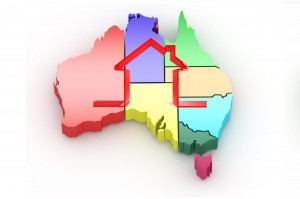The median selling price of vacant land continued to climb in capital city markets throughout 2016 while in regional areas prices have fallen.
The other big shift over the past 12 months has been the fairly significant increase in lot sizes after they have trended lower over many years.
Throughout 2016, the median selling price of capital city vacant land was recorded at $253,000 while across the combined capital cities it was recorded at $151,000.
Over the past year, median land prices in the capital cities have increased by 4.1% and combined regional markets have recorded an -8.5% fall in prices.
The 4.1% annual increase in capital city median vacant land prices was the largest annual increase since the 12 months to March 2015.
The -8.5% fall in median selling prices of regional vacant land was the largest annual fall on record.
The rise in capital city land prices while regional prices fall is reflective of what is happening in terms of broader housing market conditions.
Capital city dwelling values are rising while many regional areas are experiencing value falls.
Across the state capital cities, the median vacant land selling prices in 2016 were recorded at: $450,000 in Sydney, $242,000 in Melbourne, $229,000 in Brisbane, $220,000 in Adelaide, $258,000 in Perth and $164,000 in Hobart.
Over the past 12 months, vacant land prices have increased in Sydney (+20.5%), Melbourne (+9.5%), Brisbane (+1.8%), Adelaide (+5.3%) and Hobart (+13.1%) while they have fallen by -2.6% in Perth.
The rise in land prices over the year are approximately in line with the rises in dwelling prices, with Perth the only state capital cities in which dwelling values fell throughout 2016.
The data also highlights one of the reasons why housing affordability is such an issue in Sydney.
If the typical land cost is $450,000 it is difficult to fathom how brand new houses can be sold for any less than $600,000 considering a very conservative $150,000 build cost.
Although vacant land prices have increased across most other capital cities, the cost of land remains substantially lower than it is in Sydney.
Outside of the state capital cities the cost of vacant land is substantially lower.
At the end of 2016, the median selling prices of vacant land were recorded at: $164,000 in regional NSW, $143,000 in regional Vic, $187,500 in regional Qld, $95,000 in regional SA, $170,000 in regional WA and $96,000 in regional Tas.
Regional Vic is the only regional area in which land prices have increased over the past year (+5.9%) with falls recorded in regional NSW (-2.4%), regional Qld (-11.5%), regional SA (-5.0%), regional WA (-2.3%) and regional Tas (-3.0%).
The selling price of vacant land in Sydney is almost three times greater than vacant land prices in regional NSW while Adelaide is the only other capital city in which land prices are more than double that of regional areas.
At the end of 2016, the median lot size of residential vacant land sales over the year was recorded at 459 sqm across the combined capital cities and a substantially greater 850 sqm across the combined regional markets.
Over the year, median lot sizes increased from 450 sqm a year ago across the capital city markets and from 762 sqm for the combined regional markets.
The recent uptick in lot sizes goes against the grain of the long-term trend towards smaller lot sizes.
This may be indicative of the fact that developers have shrunk lot sizes to such a point that buyers are no longer willing to purchase smaller lots, particularly when you consider that most new lots are on the outskirts of the city where you would expect more, not less land area.
Most of the capital cities tracked have recorded an increase in lot sizes of land sold in 2016. 
Over the year, median land sizes were recorded at: 620 sqm in Sydney, 453 sqm in Melbourne, 556 sqm in Brisbane, 439 sqm in Adelaide, 395 sqm in Perth and 824 sqm in Hobart.
Over the past year, land sizes have increased in all capital cities except Perth (-2.6%) with the increases recorded at: +23.4% in Sydney, +3.1% in Melbourne, +12.1% in Brisbane, +7.1% in Adelaide and +2.5% in Hobart.
The 620 sqm median land size across sales over the past year in Sydney was the greatest since the 12 months to September 2006.
Melbourne’s median land size was the greatest since November 2014, in Brisbane it was the largest lot size since January 2013, it was Adelaide’s greatest land size since October 2009 and Hobart’s largest land size since July 2007.
In regional areas of the country buyers get a lot more land for their money.
Across the rest of state areas the median lot size of vacant land sold in 2016 was recorded at: 940 sqm in regional NSW, 750 sqm in regional Vic, 818 sqm in regional Qld, 978 sqm in regional SA, 800 sqm in regional WA and 1,080 in regional Tas.
The median lot size has increased over the past year in each of the rest of state areas analysed.
In comparison to their capital city markets, median lot sizes are substantially larger in each of the regional areas than they are within the capital cities.
The median rate/sqm for vacant land across the combined capital cities in 2016 was recorded at $553 while it was a substantially lower $156 across the combined regional markets.
Over the past year, capital city land prices have increased as have lot sizes and the rate/sqm has increased by 3.4% over the year.
In regional markets, land prices have fallen while lot sizes have increased and subsequently on a rate/sqm basis prices have fallen by -20.7% over the year.
Vacant land in Sydney cost $808/sqm in 2016 while across the other state capital cities it cost: $534/sqm in Melbourne, $407/sqm in Brisbane, $484/sqm in Adelaide, $670/sqm in Perth and $144/sqm in Hobart.
On a rate/sqm basis, the changes in prices over the past year have been recorded at +3.7% in Sydney, +6.2% in Melbourne, -9.1% in Brisbane, -4.4% in Adelaide, +0.4% in Perth and -13.3% in Hobart.
Throughout the regional areas of the states, the cost of land has largely fallen over the past year on a rate/sqm basis.
The median rate/sqm for vacant land is currently recorded at: $139/sqm in regional NSW, $178/sqm in regional Vic, $200/sqm in regional Qld, $91/sqm in regional SA, $210/sqm in regional WA and $62/sqm in regional Tas.
Over the past year, the change in vacant land prices on a rate/sqm basis have been recorded at: -24.9% in regional NSW, +0.5% in regional Vic, -34.8% in regional Qld, -13.2% in regional SA, -12.5% in regional WA and -17.9% in regional Tas.
In each state, the cost of land on a rate/sqm basis is less than half that of the price in the capital city.
In fact, in Sydney and Adelaide the cost of vacant land is more than five times more expensive than the cost of vacant land in regional NSW and regional SA respectively.
The data presented here highlights the housing affordability challenge, particularly within Sydney where it is virtually impossible to buy land and build a house for less than $600,
The data also shows that outside of the capital cities and within the less populous capital cities the cost of vacant land is substantially lower and in many instances the land sizes are much larger.
Given this the simple answer to housing affordability is for people to move away from the larger capital cities, unfortunately it is not quite that easy.
The way in which Australian businesses work is such that most businesses are located in major capital cities and regional areas of the country tend to have their employment more focused on industries such as tourism, mining and associated services or agriculture.
Furthermore, most businesses still require employees to work from the offices and those employees who are likely to be offered flexible working arrangements tend to be older and longer tenured employees, largely those that already own a home and aren’t struggling to break into the housing market.
The cost of vacant land in capital cities is also being driven higher by a lack of supply, not in a physical sense but in the sense of the supply of land ready and able to be built upon.
Zoning restrictions on the outskirts of cities limit land supply and result in it taking longer to bring residential vacant land to the market.
Furthermore, most of the vacant land is owned or optioned by large private development companies.
These businesses seek to maximise their profits so from their perspective there is little incentive to bring too much supply to the market at any one time, thus ensuring that the cost of vacant land remains high.
The cost of vacant land is also influenced by the cost of getting approval to develop the land.
Governments impose many charges on developers and ultimately these costs are not worn by the developer, rather these costs are passed on to the end user, i.e. the purchaser of the vacant land.
Making vacant land cheaper would help to make housing more affordable.
Some areas that governments should be looking at in order to make land more affordable include: increasing the supply of land that is developable, encourage land owners to bring on supply quicker (perhaps look at increasing land tax on undeveloped land) and look at reforming development fees and charges imposed on new development.
Another factor Governments should look at to help housing affordability is improving intra-city connectivity.
Instead of spending billions on fast rail between the major east coast cities, use that money to improve interconnectivity (both in terms of rail service and rail speed) between the capital cities and relatively nearby regional areas where land and housing costs are significantly lower.
Businesses can help with housing affordability too by adopting more flexible working arrangements for all staff.
If possible, they could also look to shift jobs away from the more expensive capital cities.
Not only would this help economies outside of Sydney and Melbourne they would most likely also find that both staff and accommodation costs would be significantly lower outside of the larger capital cities.














No comments:
Post a Comment